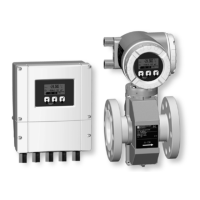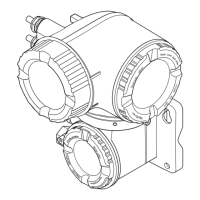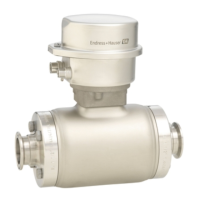5Operation
PROline Promag 53
68 Endress+Hauser
Confirming error messages
For the sake of plant and process safety, the measuring device can be configured in
such a way that fault messages ( $) always have to be rectified and acknowledged
locally by pressing F . Only then do the error messages disappear from the display.
This option can be switched on or off by means of the “ACKNOWLEDGE FAULT
MESSAGES” function (see the “Description of Device Functions” manual).
!
Note:
• Fault messages ( $) can also be reset and confirmed via the status input.
• Notice messages (!) do not require acknowledgment. Note, however, that they remain
visible until the cause of the error has been rectified.
5.4 Communication (HART)
In addition to local operation, the measuring device can be configured and measured
values can be obtained by means of the HART protocol. Digital communication takes
place using the 4–20 mA current output HART (see Page 55).
The HART protocol allows the transfer of measuring and device data between the HART
master and the field devices for configuration and diagnostics purposes. The HART
master, e.g. a handheld terminal or PC-based operating programs (such as FieldTool),
require device description (DD) files which are used to access all the information in a
HART device.
Information is exclusively transferred using so-called “commands”. There are three
different command groups:
Universal commands:
All HART devices support and use universal commands. The following functionalities
are linked to them:
• Identify HART devices
• Reading digital measured values (volume flow, totalizer, etc.)
Common practice commands:
Common practice commands offer functions which are supported and can be executed
by most but not all field devices.
Device-specific commands:
These commands allow access to device-specific functions which are not HART stand-
ard. Such commands access individual field device information, amongst other things,
such as empty/full pipe calibration values, low flow cutoff settings, etc.
!
Note!
Promag 53 has access to all three command classes. On Page 70, you will find a list
with all the supported “Universal Commands” and “Common Practice Commands”.

